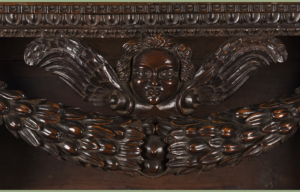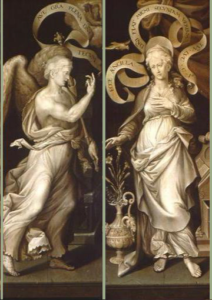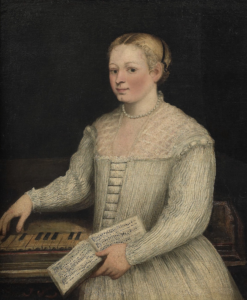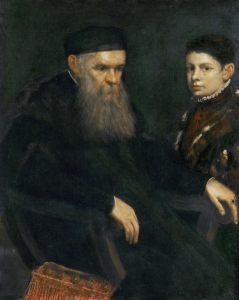Procession to Calvary
Polychrome Spanish, 1500s
Below the image, click play to listen.
Following Titian’s death in 1576, Tintoretto became the leading artist in Venice.
Walnut
16th century, Italian
When one thinks of prayer, furniture is not usually the first thing to come to mind. In Matthew 6:5-6, Christ encouraged making requests in prayer privately, rather than praying to be noticed publicly. However, a common piece of furniture constructed for the purpose of prayer was manufactured during the Renaissance and is still being made today. It is known as a prie-dieu, derived from French for “praying to God.” This special furnishing serves the same purpose as a prayer desk and a prayer chair.
M&G currently has two prie-dieux in its collection. These may have been used in a church, cathedral, or even a home. As a common piece of liturgical furniture in the Roman Catholic Church, they are still in use for worship, weddings, and funerals. When President Kennedy was lying in state, prie-dieux were in the same room.
 Both of M&G’s Prie Dieux are from Italy, dating to the early Renaissance in the late 15th to mid-16th centuries. Ornately carved walnut adds to the richness of their finish. One has a hinged kneeler with a raised panel door in the middle and a small drawer at the top. The other’s “lectern top” sits on “two powerful scroll consoles edged with gouge carving in a scale effect; the base terminates in small posts with pine-cone finials.” However, “the most striking feature is the festoon suspended from the top” with “fruit-and-leaf forms enclosing a winged angel head.”
Both of M&G’s Prie Dieux are from Italy, dating to the early Renaissance in the late 15th to mid-16th centuries. Ornately carved walnut adds to the richness of their finish. One has a hinged kneeler with a raised panel door in the middle and a small drawer at the top. The other’s “lectern top” sits on “two powerful scroll consoles edged with gouge carving in a scale effect; the base terminates in small posts with pine-cone finials.” However, “the most striking feature is the festoon suspended from the top” with “fruit-and-leaf forms enclosing a winged angel head.”
Additionally, two paintings in M&G’s collection include prie-dieux. Both pictures highlight the importance of the Annunciation. The archangel Gabriel came to Mary to inform her that she had found grace in the sight of God. She would be privileged to bear the long-awaited Messiah, Jesus Christ. Christ Himself would become the only means of access to God the Father—through prayer. As explained in I Timothy 2:5-6, this direct access was accomplished through His passion and resurrection, which is symbolized by an open door on the prie-dieu. Fellowship with God in heaven is available to all people.
St. Gabriel the Archangel and The Virgin Annunciate by Venetian Reniassance painter, Francesco Montemezzano, were formerly one complete canvas (with one other M&G painting of God the Father depicted with a group of angels). These works were separated into three sections, which are all in M&G’s collection. The artist depicts Mary kneeling at her prie-dieu as she converses with Gabriel, who is seen on the opposite canvas.
The Altar Wings with Scenes from the Birth of Christ was created by an unknown Netherlandish artist. These wood panel paintings were completed during the same century as the Montemezzano canvases—roughly mid to late 1500s. Once the hinged doors of a larger altarpiece, these special panels hid the interior artistic scenes, which would be opened for special services or events. The interior paintings were in vivid color; however, the exterior doors like these were usually painted in gray tones, known as grisaille. This technique suggested a sculptural effect. Gabriel the archangel is positioned on the left panel facing Mary on the right. Mary is depicted with a lily (symbolic of her purity and Christ’s future resurrection) and a prie-dieu (on the far-right edge).
Prie-dieux are found in museum collections around the world—both as furniture and within the pictorial settings of Old Master paintings. London’s Victoria and Albert Museum has a prie-dieu closely resembling one of M&G’s. The National Gallery’s Venetian Annunciation depicts Mary sitting at a prie-dieu.
Prayer is more often discussed than practiced. Fortunately, the opportunity exists for not only God’s children to approach their Heavenly Father, but anyone seeking His help—with or without a prie-dieu.
John Good, Security Manager
Published 2021
Further Resources:
Aronson, Joseph, Furniture in the Bob Jones University Collection
Hiebert, D. Edmond, Working With God Through Prayer
At the dawn of the 16th century Mannerism was gaining in popularity. Even noted Renaissance painters like Raphael began to mirror the style, but it was the Sienese painter Giovanni Antonio Bazzi who would push the mannerist vision even further.
Oil on canvas
16th or 17th century
This beautiful 16th or 17th century work by an unknown Italian artist stands out due to its rectangular shape spanning approximately 9 ½ feet long. The artist used the entire length of the painting to masterfully demonstrate his knowledge of architecture and perspective. He also illustrates Palladian-style architecture which was inspired by Ancient Greek and Roman temples and focused on symmetry and proportion based on mathematical principles. The massive Corinthian columns, Roman-style sculptures in the niches along the arcade, and decorative motifs above each of the many doorways further exemplify the Palladian character of the structure. The painting also demonstrates the realistic use of lighting and perfect proportion of the figures (clad with a variety of rich, vibrant color) in comparison with the enormous temple-like structure. The actual site of the Pool of Bethesda, the subject of this painting, was discovered in the late 19th century confirming its description in the Gospel of John.
The artist captures one of only two miracles Jesus performed in Jerusalem. For those living in this part of the world, water was vital to all aspects of life. The Pool of Bethesda was no exception. The pool was divided into two reservoirs with one most likely functioning as a ritual bath (mikveh) and the other used to replenish it. Many sick, lame, and blind came to the pool because of the pool’s supposed healing powers, a long held pagan tradition. They believed that an angel would come and stir the waters and whoever stepped into the water first would be healed of his ailment (John 5:3-4).
Jesus knew there would be large crowds attending a religious festival in Jerusalem (John 5:1) and therefore, witnesses to what he was about to do. To the right of the painting, Jesus, wearing a dark blue cloak, and accompanied by a few of his disciples, approaches one of the many invalids. Jesus specifically chose a crippled man who had been ill for 38 years. Jesus asks him, “wilt thou be made whole?” (John 5:6) The invalid tells Jesus that he has no one to help him into the water and that he can never get to the water before someone steps in before him. Jesus does not lay hands on the man or touch him in any way but instead commands the invalid to get up, pick up his bed and walk. Miraculously, the man is completely healed by only words of Jesus.
The miracle of the lame man’s physical restoration revels Jesus’s identity as the Jewish people’s long-awaited Messiah. Instead, the Jewish leaders remained spiritually blind focusing only on the fact that Jesus healed a man on the sabbath which violated their oral traditions expanded from the Law of Moses. Jesus later finds the healed man in the temple and in addition to physical healing offers spiritual healing encouraging the man to “sin no more” (John 5:14). This miracle not only showcases Christ’s compassion for those enduring physical afflictions but also, and more importantly, reveals His desire to provide spiritual healing for all from the ravages of sin.
Rebekah Cobb, Registrar
Published 2021
Oil on Canvas
Venetian, 1519-1594
Oil on Canvas
Venetian, c. 1554- c.1590
Jacopo Robusti, better known by his nickname, Il Tintoretto, was one of the most sought after and prolific painters in sixteenth-century Venice. He never lacked for commissions throughout his life and produced some of the city’s most famous canvases. The Visit of the Queen of Sheba to Solomon from the Museum & Gallery collection is one of his early works.
 Jacopo’s success was in part due to his bustling family workshop which included two of his sons and Marietta his daughter, painter of M&G’s Allegory of Wisdom. In an article on Marietta, Louise Arizzoli points out that “Our reading of Renaissance masters as individual geniuses that started with Vasari’s Lives, sheds a negative light on those collaborators who remained in the shadow of the leading artist. These family workshops have however to be understood as teamwork, in which every member had specific responsibilities in order to ensure the quality of the commissions. Therefore, it is particularly difficult for us now to recognize individualities, as it was not the aim of the workshop to enhance individual style but to produce a certain style—that of Tintoretto” [Italics added]. This is one reason that apart from a small number of religious paintings and the Self-Portrait above (now in the Uffizi) few works are definitively assigned to Marietta. In addition, her talents were a close match to her father’s. This is especially evident in the figural details and similarities of brushwork and coloration in the two M&G works showcased.
Jacopo’s success was in part due to his bustling family workshop which included two of his sons and Marietta his daughter, painter of M&G’s Allegory of Wisdom. In an article on Marietta, Louise Arizzoli points out that “Our reading of Renaissance masters as individual geniuses that started with Vasari’s Lives, sheds a negative light on those collaborators who remained in the shadow of the leading artist. These family workshops have however to be understood as teamwork, in which every member had specific responsibilities in order to ensure the quality of the commissions. Therefore, it is particularly difficult for us now to recognize individualities, as it was not the aim of the workshop to enhance individual style but to produce a certain style—that of Tintoretto” [Italics added]. This is one reason that apart from a small number of religious paintings and the Self-Portrait above (now in the Uffizi) few works are definitively assigned to Marietta. In addition, her talents were a close match to her father’s. This is especially evident in the figural details and similarities of brushwork and coloration in the two M&G works showcased.
 These mysteries of attribution are not only on-going but truly fascinating. For example, many scholars believe that several of Marietta’s works may simply have been incorporated into her father’s oeuvre. For example, Old Man and a Boy (Kunsthistorisches Museum) was considered one of Jacopo’s best portraits, but in 1920 Duncan Bull, a curator at the Rijksmuseum, reassigned the attribution to Marietta on the basis of the ‘M’ signature discovered on the work. (The ‘M’ is in the lower right of canvas beside the chair arm.) However, there are still scholars reluctant to accept this re-attribution.
These mysteries of attribution are not only on-going but truly fascinating. For example, many scholars believe that several of Marietta’s works may simply have been incorporated into her father’s oeuvre. For example, Old Man and a Boy (Kunsthistorisches Museum) was considered one of Jacopo’s best portraits, but in 1920 Duncan Bull, a curator at the Rijksmuseum, reassigned the attribution to Marietta on the basis of the ‘M’ signature discovered on the work. (The ‘M’ is in the lower right of canvas beside the chair arm.) However, there are still scholars reluctant to accept this re-attribution.
Two other important biographers detailing Tintoretto’s (and by extension Marietta’s) career are Raffaele Borghini (1537-1588) and Carlo Ridolfi (1594-1658). Both writers note that Marietta was not only exceptionally talented but also her father’s favorite. In his Le Maraviglie dell’Arte Ridolfi writes:
Marietta Tintoretto, then, lived in Venice, the daughter of the famous Tintoretto and the dearest delight of his soul. He trained her in design and color, whence later she painted such works that men were amazed by her lively talent. Being small of stature she dressed like a boy. Her father took her with him wherever he went and everyone thought she was a lad. She made a portrait of Jacopo Strada, the antiquarian of Emperor Maximilian, who presented it to his majesty as a rare work, whence the emperor, charmed by her valor, made enquiries about her of her father. Philip II, the King of Spain, and Archduke Ferdinand also asked him about her. However, Tintoretto was satisfied to see her married to Mario [Marco] Augusta, a jeweler, so that she might always be nearby, rather than be deprived of her, even though she might be favored by princes, as he loved her tenderly […] When she died her father wept bitterly, taking it as the loss of a part of his own inner being.
Marietta died four years before her father around 1590. The exact cause of her death is uncertain, but many believe she died in childbirth. Regardless, Ridolfi’s account of the close personal and professional relationship between the two would blur “into the myth of a young and talented woman painter who died too soon, leaving her father heart-broken.” We do know that Jacopo’s output began to fall off after his daughter’s death—whether because of grief or because of the loss of collaborative talent cannot be known. In any case, she would eventually become a muse for 19th century painters. Léon Cogniet’s Tintoretto Painting his Dead Daughter is perhaps the most famous among these Romantic paintings.
Donnalynn Hess, Director of Education
Published in 2021
Paris Bordone studied for a time under Titian, the greatest Venetian artist of the 16th century. Although forced to leave this great master’s studio, Bordone went on to excel in portraiture, large-scale architectural settings, and cabinet paintings.